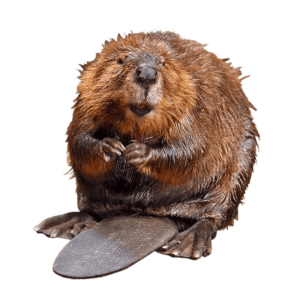
BEAVER
Scientific Name: Genus castor
Fun Fact:
Beavers front teeth are orange. It’s not because of bad hygiene. It’s because they contain iron which makes their teeth super strong and sharp. They have to be to fell the hundreds of trees necessary to create their lodges.
Lifespan: Beavers have a lifespan of 10-15 years in the wild, and can live to 24 years in captivity
Description
The beaver is a large, primarily nocturnal, semiaquatic rodent. Castor includes two species: the North American beaver (Castor canadensis) native to North America and Eurasian beaver (Castor fiber)located in Europe. Beavers are known for building dams, canals, and lodges (homes). They are the second-largest rodent in the world. Beaver colonies create one or more dams to provide still, deep water to protect against predators, and to float food and building material. The North American beaver population was once more than 60 million, but as of 1988 was 6–12 million. This population decline is the result of extensive hunting for fur, for glands used as medicine and perfume, and because the beavers’ harvesting of trees and flooding of waterways may interfere with other land uses.
They are known for their alarm signal: when startled or frightened, a swimming beaver will rapidly dive while forcefully slapping the water with its broad tail, audible over great distances above and below water. This serves as a warning to beavers in the area. Once a beaver has sounded the alarm, nearby beavers will dive and may not reemerge for some time. Beavers are slow on land, but are good swimmers, and can stay under water for as long as 15 minutes.
Beavers do not hibernate, but store sticks and logs in a pile in their ponds, eating the underbark. Some of the pile is generally above water and accumulates snow in the winter. This insulation of snow often keeps the water from freezing in and around the food pile, providing a location where beavers can breathe when outside their lodge.
Beavers have webbed hind-feet, and a broad, scaly tail. They have poor eyesight, but keen senses of hearing, smell, and touch. A beaver’s teeth grow continuously so that they will not be worn down by chewing on wood.[5] Their four incisors are composed of hard orange enamel on the front and a softer dentin on the back. The chisel-like ends of incisors are maintained by their self-sharpening wear pattern. The enamel in a beaver’s incisors contains iron and is more resistant to acid than enamel in the teeth of other mammals.
Beavers continue to grow throughout their lives. Adult specimens weighing over 55 lb are not uncommon. Females are as large as or larger than males of the same age, which is uncommon among mammals. Beavers live up to 24 years of age in the wild.
Diet
Beavers are large rodents that definitely enjoy vegetation — including twigs, foliage, bark and aquatic plants. Their diets change by the season. The inner bark of trees are a beaver favorite, according to the New York State Department of Environmental Consumption. During the warm summertime, woody plants usually are only about 10 percent of a beaver’s consumption. Aspen trees are usually the preference, although beavers feed on black cherry, beech, maple, alder and birch trees as well. Apart from just the bark, beavers enjoy eating the “cambium” of trees, which is the name for the very soft and smooth layer just below the bark. When it comes to woody plants, beavers do not stop at the bark and cambium. The animals also frequently consume the twigs and foliage of various trees, especially red maples, willows and aspens.
Rather than consume copious amounts of woody plants during the summertime, the beaver eats mostly aquatic plants and sedge plants. Rhizomes, pond weeds, bulrush, cattails and water lilies are just a couple of common summertime beaver “dishes.” In the spring and summer, ferns, leaves and grasses are all big components of beaver meals.
How to Get Rid of Beaver
Unfortunately, there aren’t many ways to get rid of beaver that don’t involve dispatching it. The dams they create are usually too well constructed to be easily taken down by land owners and the animal itself is difficult to catch. Snares and foothold traps are usually employed to catch beaver. They are rarely relocated and are usually shot. This is another example of a job better left to professional animal removal companies. If you are having trouble with beavers in Georgia or Alabama, call Jarrod’s Pest Control. We are experts in beaver removal and guarantee our work. You’ll be satisfied or we’ll keep coming back until you are.
(706) 221-8000
REQUEST A QUOTE

100% Satisfaction
There is a reason our work is guaranteed…we do it right. If you would ever have a problem with pests while we are in charge of your pest control, we will work until the problem is resolved. Our contracts provide you with quarterly service and we will take care of any problems that may happen to arise between visits.
We Guarantee It!

Request Free Pest Inspection
EMERGENCY SERVICE AVAIALBLE
Request Free Pest Inspection
EMERGENCY SERVICE AVAIALBLE

